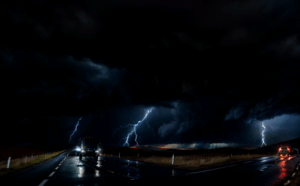Residents across Perth and Kinross woke Monday to the formidable force of Storm Floris, as an amber weather warning for severe winds brought widespread disruption to the region. The Met Office had cautioned about “unseasonably strong and disruptive” gusts, potentially reaching up to 90mph, posing a significant risk of danger from flying debris and large waves. The impact has been felt keenly across Tayside, Fife, and Stirling, with numerous services and transportation links in Perthshire experiencing immediate effects.
Roads and bridges crucial for connectivity within and around Perth and Kinross faced escalating restrictions throughout the day. The Tay Road Bridge, a vital link for many in the area, was initially limited to cars only and closed entirely to double-decker buses and high-sided vehicles due to ferocious winds. By Monday afternoon, concerns over motorist safety led to its complete closure to all traffic, mandating diversions via Perth – a measure that significantly altered travel plans for countless individuals. Similarly, the Forth Road Bridge, Queensferry Crossing, and Kincardine Bridge saw closures for high-sided vehicles, rerouting double-decker bus services through Stirling and bypassing key stops such as Kinross and Halbeath, impacting commuters and travelers from across Perth and Kinross. Rail and Local Road Networks Under Strain
Train services, a lifeline for many in the region, were severely curtailed. A major operator announced the cancellation of all trains north of Newcastle, directly affecting routes to and from Perth, Fife, and Dunblane. Other rail services experienced reduced timetables and enforced 50mph speed limits as a safety precaution, with warnings that Tuesday’s services could also be impacted. Local authorities were stretched thin responding to hazardous conditions. In Stirling, a fallen tree near Cornton blocked railway tracks, requiring immediate clearance by Network Rail teams. Reports also emerged of substantial tree branches partially obstructing the A84 at Castleview Car Park in Stirling, and traffic light failures in Raploch, further compounding local travel challenges near Perthshire.
Specific local roads faced their own battles against the elements. The A873 between Thornhill and Aberfoyle in Stirlingshire, an area bordering Perth and Kinross, was temporarily closed, highlighting the localized nature of the storm’s fury. While this particular stretch later reopened, another incident involving a collision and a fallen tree on the A84 near Keltie Bridge in Callander caused further restrictions and traffic build-up, impacting routes frequently used by Perthshire residents. In Monifieth, a tree blocked Lorne Street, underscoring the widespread nature of the fallen debris hazard. Power Outages and Service Adjustments
Power supplies across Perth and Kinross were not immune to Floris’s wrath. SP Energy Networks reported outages in several local postcodes, including areas near Milnathort, Methven, and Braco, prompting the utility provider to deploy additional field engineers and alert over 100,000 vulnerable customers via text. Residents were advised to monitor SSEN’s live power outage tracker for the most current information.
Public services also adjusted operations to prioritize safety. Stirling Council closed the Lower Polmaise Household Waste and Recycling Centre, impacting waste management for residents in nearby communities. Angus Council mirrored this by suspending bin collections and closing all recycling centres from midday. While Perth and Kinross Council’s specific waste management updates for Monday weren’t detailed, residents were advised to stay alert to local authority announcements, and bin collections in neighboring Dundee were also halted. Impact on Local Attractions and Public Safety Advice
Beloved local attractions in and around Perth and Kinross also felt the storm’s pinch. Scone Palace, a major draw for visitors, took the precautionary step of closing its gardens, although the palace itself remained accessible at a reduced ticket price. Further afield, the National Wallace Monument in Stirling, and the Dundee Museum of Transport also closed their doors for the day. Local transport services like the Trossachs Explorer bus, which connects Callander and Aberfoyle within the Loch Lomond & The Trossachs National Park, were suspended due to safety concerns.
Police Scotland reiterated crucial advice for navigating the treacherous conditions: ensuring mobile phones are charged, planning alternative routes, carrying emergency supplies, and crucially, never ignoring road closure signs – a reminder of the serious nature of the amber warning. As the amber alert remained active throughout Monday, authorities urged residents across Perth and Kinross to continue prioritizing safety and to stay informed through official channels regarding the ongoing impact and recovery efforts. ” “positive_prompt”: “A dramatic, photo-realistic scene of a severe windstorm impacting a Scottish landscape near Perth. Gusts of wind whip heavy rain, bending trees. In the foreground, a prominent road sign indicates a bridge closure, with blurred car headlights suggesting diverted traffic. The sky is dark and turbulent, with ominous storm clouds. The mood is intense and chaotic, but without direct visual distress to people or property (no active damage, just the atmospheric impact). The scene captures the raw power of nature in the Scottish countryside.
Roads and bridges crucial for connectivity within and around Perth and Kinross faced escalating restrictions throughout the day. The Tay Road Bridge, a vital link for many in the area, was initially limited to cars only and closed entirely to double-decker buses and high-sided vehicles due to ferocious winds. By Monday afternoon, concerns over motorist safety led to its complete closure to all traffic, mandating diversions via Perth – a measure that significantly altered travel plans for countless individuals. Similarly, the Forth Road Bridge, Queensferry Crossing, and Kincardine Bridge saw closures for high-sided vehicles, rerouting double-decker bus services through Stirling and bypassing key stops such as Kinross and Halbeath, impacting commuters and travelers from across Perth and Kinross. Rail and Local Road Networks Under Strain
Train services, a lifeline for many in the region, were severely curtailed. A major operator announced the cancellation of all trains north of Newcastle, directly affecting routes to and from Perth, Fife, and Dunblane. Other rail services experienced reduced timetables and enforced 50mph speed limits as a safety precaution, with warnings that Tuesday’s services could also be impacted. Local authorities were stretched thin responding to hazardous conditions. In Stirling, a fallen tree near Cornton blocked railway tracks, requiring immediate clearance by Network Rail teams. Reports also emerged of substantial tree branches partially obstructing the A84 at Castleview Car Park in Stirling, and traffic light failures in Raploch, further compounding local travel challenges near Perthshire.
Specific local roads faced their own battles against the elements. The A873 between Thornhill and Aberfoyle in Stirlingshire, an area bordering Perth and Kinross, was temporarily closed, highlighting the localized nature of the storm’s fury. While this particular stretch later reopened, another incident involving a collision and a fallen tree on the A84 near Keltie Bridge in Callander caused further restrictions and traffic build-up, impacting routes frequently used by Perthshire residents. In Monifieth, a tree blocked Lorne Street, underscoring the widespread nature of the fallen debris hazard. Power Outages and Service Adjustments
Power supplies across Perth and Kinross were not immune to Floris’s wrath. SP Energy Networks reported outages in several local postcodes, including areas near Milnathort, Methven, and Braco, prompting the utility provider to deploy additional field engineers and alert over 100,000 vulnerable customers via text. Residents were advised to monitor SSEN’s live power outage tracker for the most current information.
Public services also adjusted operations to prioritize safety. Stirling Council closed the Lower Polmaise Household Waste and Recycling Centre, impacting waste management for residents in nearby communities. Angus Council mirrored this by suspending bin collections and closing all recycling centres from midday. While Perth and Kinross Council’s specific waste management updates for Monday weren’t detailed, residents were advised to stay alert to local authority announcements, and bin collections in neighboring Dundee were also halted. Impact on Local Attractions and Public Safety Advice
Beloved local attractions in and around Perth and Kinross also felt the storm’s pinch. Scone Palace, a major draw for visitors, took the precautionary step of closing its gardens, although the palace itself remained accessible at a reduced ticket price. Further afield, the National Wallace Monument in Stirling, and the Dundee Museum of Transport also closed their doors for the day. Local transport services like the Trossachs Explorer bus, which connects Callander and Aberfoyle within the Loch Lomond & The Trossachs National Park, were suspended due to safety concerns.
Police Scotland reiterated crucial advice for navigating the treacherous conditions: ensuring mobile phones are charged, planning alternative routes, carrying emergency supplies, and crucially, never ignoring road closure signs – a reminder of the serious nature of the amber warning. As the amber alert remained active throughout Monday, authorities urged residents across Perth and Kinross to continue prioritizing safety and to stay informed through official channels regarding the ongoing impact and recovery efforts. ” “positive_prompt”: “A dramatic, photo-realistic scene of a severe windstorm impacting a Scottish landscape near Perth. Gusts of wind whip heavy rain, bending trees. In the foreground, a prominent road sign indicates a bridge closure, with blurred car headlights suggesting diverted traffic. The sky is dark and turbulent, with ominous storm clouds. The mood is intense and chaotic, but without direct visual distress to people or property (no active damage, just the atmospheric impact). The scene captures the raw power of nature in the Scottish countryside.


